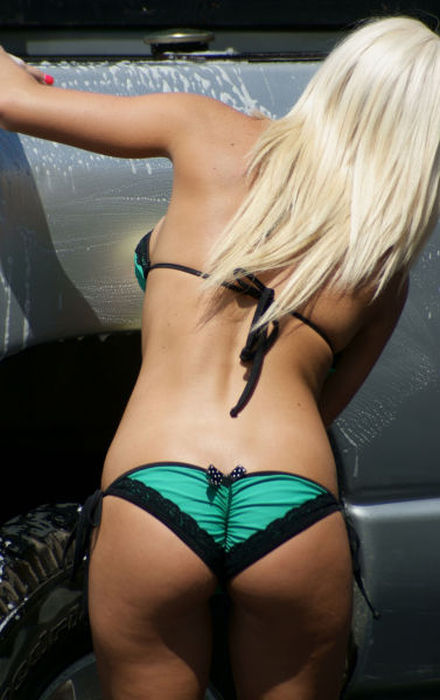|
|
Car Wash Girls
|
The first conveyorized automatic car washes appeared in the late 1930s. Conveyorized automatic car washes consist of tunnel-like buildings into which customers (or attendants) drive. Some car washes have their customers pay through a computerized POS, or point of sale unit, also known as an "automatic cashier", which may take the place of a human greeter. The mechanism inputs the wash PLU into a master computer or a tunnel controller automatically. When the sale is automated, after paying the car is put into a line-up often called the stack or queue. The stack moves sequentially, so the wash knows what each car purchased. After pulling up to the tunnel entrance, an attendant usually guides the customer onto the track or conveyor. At some washes, both tires will pass over a tire sensor, and the system will send several rollers. The tire sensor lets the wash know where the wheels are and how far apart they are. On other systems the employee may guide the customer on and hit a 'Send Car' button on the tunnel controller, to manually send the rollers which push the car through.
When the customer is on the conveyor, the attendant (or signage) will instruct the customer to put the vehicle into neutral, release all brakes, and refrain from steering. Failure to do so can cause an accident on the conveyor. The rollers come up behind the tires, pushing the car through a detector, which measures vehicle length, allowing the controller to tailor the wash to each individual vehicle. The equipment frame, or arches, vary in number and type. A good car wash makes use of many different pieces of equipment and stages of chemical application to thoroughly clean the vehicle.
The carwash will generally start cleaning with pre-soaks applied through special arches. They may apply a lower pH (mild acid) followed by a higher pH (mild alkali), or the order may be reversed depending on chemical suppliers and formula used. Chemical formulas and concentrations will also vary based upon seasonal dirt and film on vehicles, as well as exterior temperature, and other factors. Chemical dilution and application works in combination with removal systems based on either high pressure water, friction, or a combination of both. Chemical substances, while they are industrial strength, are not used in harmful concentrations since car washes are designed not to harm a vehicle's components or finish.
The customer next encounters tire and wheel nozzles, which the industry calls CTAs (Chemical Tire Applicators). These will apply specialized formulations, which remove brake dust and build up from the surface of the wheels and tires. The next arch will often be wraparounds, usually made of a soft cloth, or closed cell foam material. These wraparounds should rub the front bumper and, after washing the sides, will follow across the rear of the vehicle cleaning the rear including the license plate area. Past the first wraps or entrance wraps may be a tire brush that will scrub the tires and wheels. This low piece is often located beneath a mitter (the hanging ribbon-like curtains of cloth that move front to back or side to side) or top wheels. There may also be rocker panel washers which are shorter in size (ranging in size from 18 inches (45 cm) up to 63 inches (160 cm) tall) that clean the lower parts of the vehicle. Most rocker brushes house the motor below the brush hub so they don't inhibit cloth movement and allow the brush to be mounted under a support frame or below a mitter. Some car washes have multiple mitters, or a combination of mitters and top brushes.
|
|









